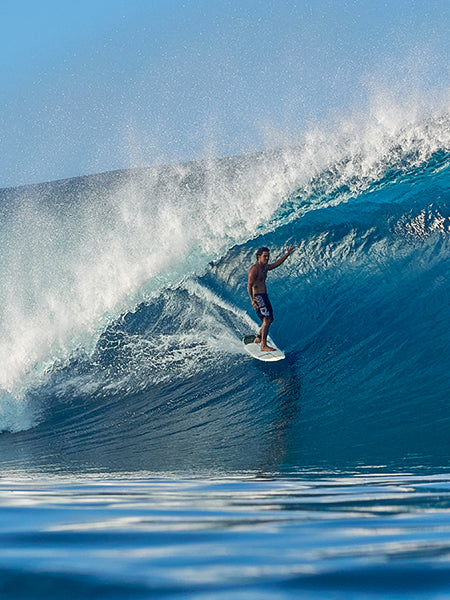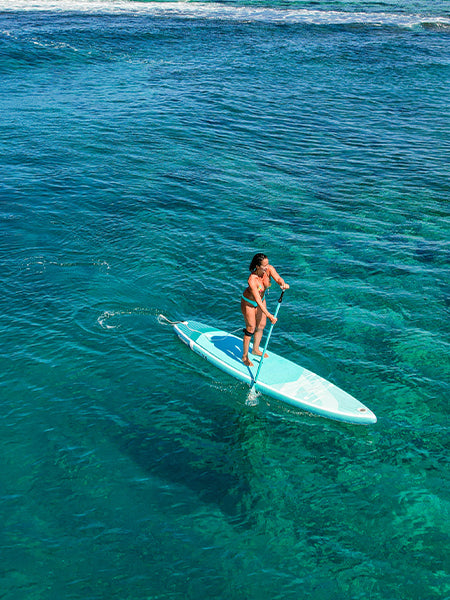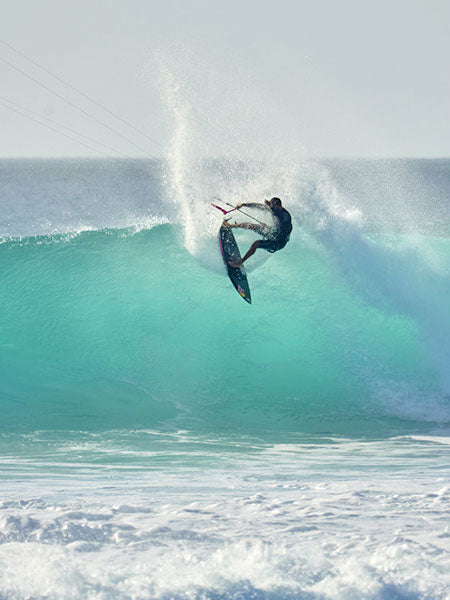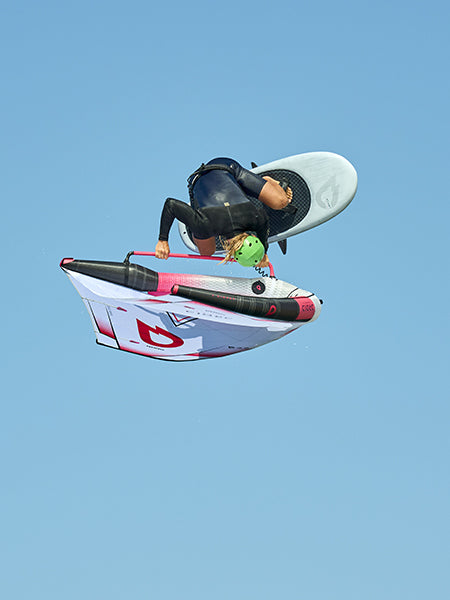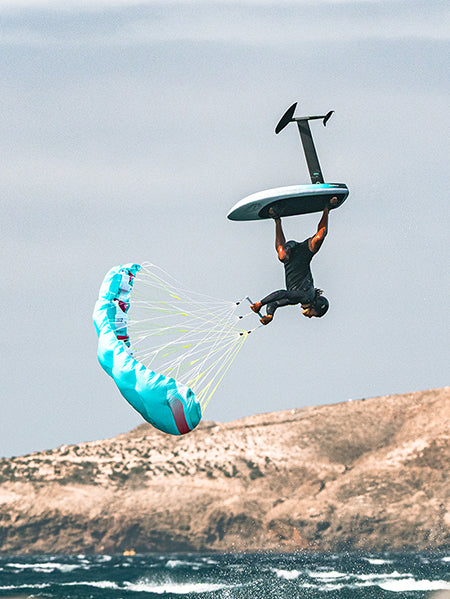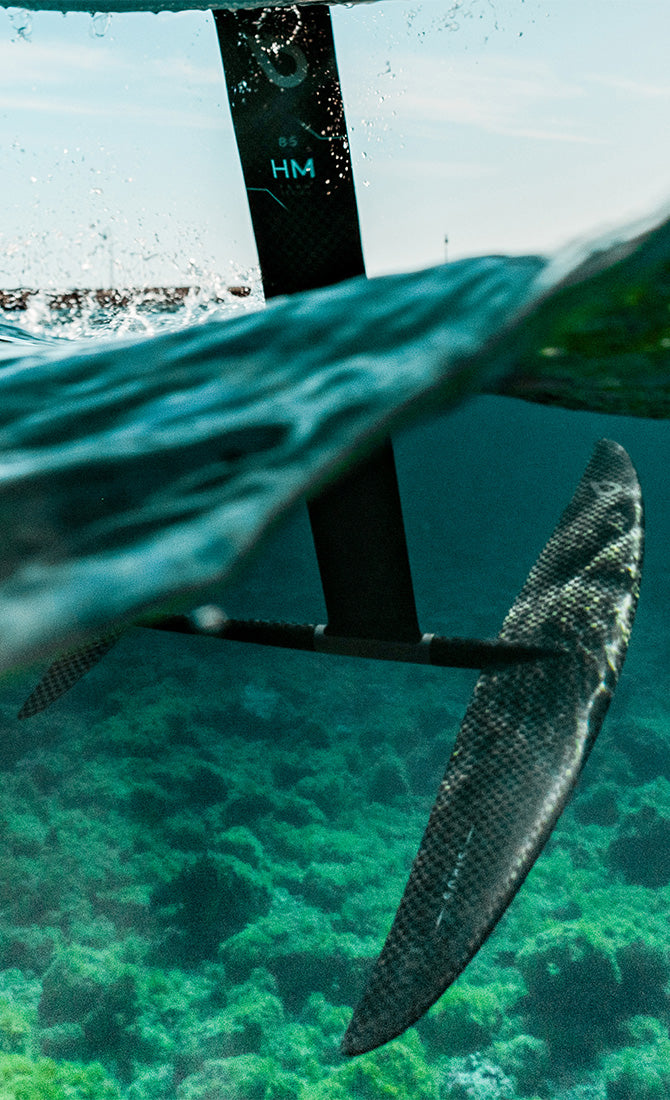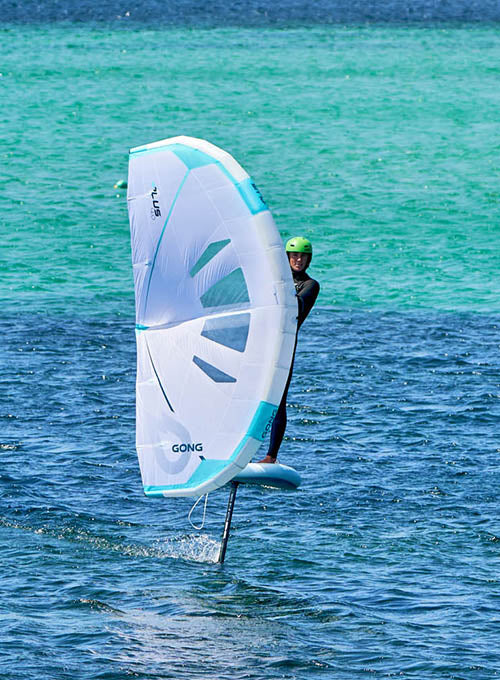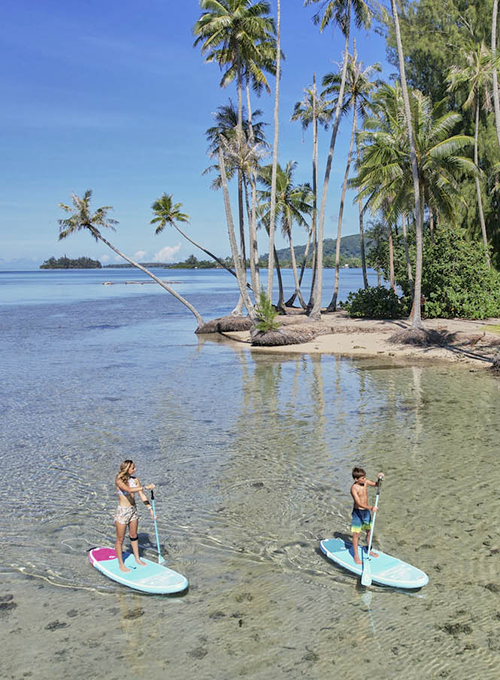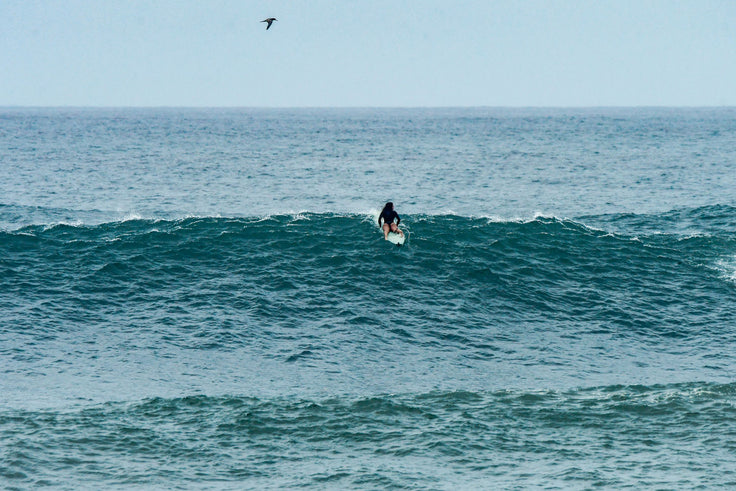Choose your kite
All our tips for selecting the perfect kite to help you learn, improve, and send it like a pro!
Some of us want a kite that's very predictable yet fun, while others long for a machine built for kiteloops or uncompromising wave riding. Your choice really depends on four parameters:
- your level,
- your program,
- your most common riding conditions,
- and your quiver.

Your level: beginner or experienced rider?
- Beginner: Choose a kite with clear bar feedback that will help you quickly get comfortable and maximize your fun. The ideal kite for beginners should have good upwind performance, enough power for light conditions, easy relaunch, and intuitive, reassuring depower. It should also have the capability to deliver strong performance as you progress. For this, consider a freeride kite like the Display.
- Experienced: You can choose between highly versatile kites like the Vertigo, which offers top performance across a range of disciplines, or focus on a specific practice like wave riding, big air, foiling, or others. Let’s explore the kites available for each program below.
 Kitesurfer: Hina, GONG team rider, with a Display kite, a Sway twin tip and a FeelX bar.
Kitesurfer: Hina, GONG team rider, with a Display kite, a Sway twin tip and a FeelX bar.
What’s your kitesurfing program?
After many years of evolution and development, kitesurfing has reached maturity. The disciplines are well-defined, and riders have developed distinct styles. There are five major categories with highly specialized kites, as well as more versatile options like the Vertigo or the Unik.

What are the differences between a Perf Series kite and a Team Series kite?
The Perf Series kites are our go-to models for the above-mentioned disciplines. They feature a traditional Dacron construction, while the Team Series and Pro Team Series kites use UPE Aramid material.
This material, significantly more rigid, lightweight, and durable, offers a responsiveness that enhances your kite’s performance, and thanks to its strength, ensures exceptional longevity.
The Pro Team Series kites also feature a double profile that enhances glide, speed, dynamism, upwind performance, and extend the range of use of your kite, as explained in this article.
 Kite foiler: Thomas, GONG staff, with his Fronteira HDCC, Ayto Aramid DP and Fluid H V3.
Kite foiler: Thomas, GONG staff, with his Fronteira HDCC, Ayto Aramid DP and Fluid H V3.
How to Choose Your Kite for Freeride, Freestyle, Foiling, or Wave Riding:
Which freeride kite to choose?
In our extensive range, we offer various "freeride" kites. Depending on your conditions and skill level, you should select a model that best fits your needs.
- Display Perf Series: The quintessential Freeride kite, it's the most versatile model no matter the level or conditions encountered! With a good low-end range and a stable 3-strut shape in strong winds, the Display has a very wide range of use, always with unparalleled simplicity! Intuitive freeriding, regardless of wind strength.
- Vertigo perf Series: Freeriding in high-performance mode! Like with the Display and the Unik, the Vertigo allows you to have a blast on any type of board. However, this kite, with its precise handling and constant traction, is best suited for experienced kiters. The Vertigo is fast, reacts very quickly, and gives an impressive jump boost. Freeride yes, but in turbocharged mode!
- Unik perf Series: Of course, it's a Freeride kite, but designed to facilitate navigation in light wind or underpowered conditions primarily. Its single-strut shape offers impressive lightness and great stability throughout the wind window. You feel safe even in 10 knots. If you frequently sail on a lightly windy spot and enjoy switching from TT to surf to foil, this model will be perfect for you!
- Strutless Perf Series: Light wind lovers will enjoy the Strutless in light or inconsistent wind conditions. With its record-breaking glide, you'll have the most efficient kite in marginal conditions, without needing to switch to a foil kite, which is usually more complicated to use, especially when it decides to take a dip ;-)
 Kitesurfers: Hina and Teke with a Sway twintip, Display kite and Elips.
Kitesurfers: Hina and Teke with a Sway twintip, Display kite and Elips.
Which freestyle kite to choose?
- Vertigo Perf Series: A versatile freestyle twin-tip kite, the Vertigo excels in everything from wakestyle to big air. Its moderate aspect ratio makes unhooked riding easier. You'll experience solid pop, slack, and stability, allowing you to push your limits with confidence. Its ultra-efficient design remains forgiving for intermediate to advanced riders. With consistent bar feedback and a wide wind range under control, it's the perfect model for going all-out in freestyle and wakestyle!
- Ayto Perf Series and Pro Team Series: Freestyle kiteloop with no limits! Looking for the kite to perform at the highest level? This kite is the real deal! Its high aspect ratio provides impressive lift, insane hang time, and delicious kiteloops, S-loops, and double loops. It's a kiteloop machine! It turns fast and hard and always with exceptional catch. Designed for uncompromising high-level big air freestyle!
- Elips Perf Series and Pro Team Series: Strapless freestyle. A wave kite at heart, its DNA derived from the Ayto provides exceptional drift along with excellent lift and remarkable responsiveness. In strapless riding, it makes grabs easier thanks to its consistent pull and stability. This is the kite to choose when you want to throw strapless loops!
- Unik Team Series or Strutless Team Series: these single-strut kites are the light and powerful solutions for true freestyle in ultra-light wind. The Unik Aramid delivers torque that allows for all kinds of bold moves in light wind. The Strutless Aramid generates phenomenal glide, resulting in impressive hangtime and great comfort for throwing tricks!
Which kite to choose for foiling?
The new Unik, Strutless and Strutless Revo offer kite foilers valuable resources to excel in the art of flying on water. Lightweight and efficient with stunning control, they are distinguished by:
- A single strut shape for the Unik, for a very versatile use with plenty of surface area in the center to enjoy torque in the lightest conditions.
- A strutless shape with 3 fiber battens for the Strutless Perf Series (and one fiber batten on the Strutless Team Series, which has smaller tip surfaces) — the ultimate concept for light wind conditions, with minimal drag and incredible performance.
- A struttless shape with a single fiber batten for the Strutless Revo, with a lower ratio than the Strutless to boost the handling in tricks and also shred waves with an ultra-efficient kite in the lighter conditions.
Qualities that allow you to approach sessions with complete confidence, to attempt tricks in all directions, whatever the quality of the conditions.
 Kite foiler: Patrice, GONG boss and shaper, with the Fronteira HDCC, Unik Aramid, HM85 mast, Ypra Freestyle front wing and Ypra Freestyle stab.
Kite foiler: Patrice, GONG boss and shaper, with the Fronteira HDCC, Unik Aramid, HM85 mast, Ypra Freestyle front wing and Ypra Freestyle stab.
Which wave kite should you choose?
In our ultra-complete range, we offer various "wave" kites. Depending on your conditions and skill level, you should choose one model over another.
- Display: The freeride kite for fast progression is also a very enjoyable wave kite due to its highly stable flight and maneuverability. It’s an excellent kite for trying out wave riding with ease.
- Vertigo: This high-performance freeride kite is a versatile all-rounder that also excels in waves thanks to its maneuverability and responsiveness. Its wide wind range is an undeniable advantage for wave riding, ensuring you stay in control.
- Ayto or Ayto Aramid DP: 100% big air and kite loops, this kite is extreme. But counterintuitively, it's also excellent for surfing with its supersonic speed and formidable maneuverability. Pro pilot only!
- Unik or unik Aramid: This light wind kite, designed for underpowered conditions, is fantastic for surfing. Firstly, it's so light that you barely notice it. Secondly, it stays high in the sky, forgiving you for any small mistakes in steering.
- Strutless Revo: The ultimate kite for maneuverability on a foil, it's also a delight for purists in surf. If you kite purely to surf and nothing else, this is exactly what it offers.
- Elips or Elips Aramid DP: The queen of waves, this kite has everything you love in a surf-specific kite: maneuverability, stability, power, drift, precision, tolerance, incredible low-end range, and fine handling. It’s the queen of the spot.
Our riders in action with the Vertigo, Atyo and Elips:
Which kite for your riding conditions?
When choosing a kite, prioritize your skill level first, then consider the riding style you prefer. It can also be useful to select a kite for light wind if those conditions are most common for you, or to ensure you cover the lower wind range with greater comfort.
Today, navigating in light wind conditions is no longer just about making simple up-and-down runs or struggling to stay upwind with a massive size of kite. Decades of development have led to such high performance levels that a “small” 11m kite can now generate more power and speed than older 19m kites!
Add to this the rise of foiling with its advanced development, and kiteboarding in 6 knots becomes not just possible but incredibly fun! Depending on the conditions you most often face and your riding style, you can choose from these three models in our extensive range:
- Unik or Unik Aramid: lightwind freeride with the Unik, or lightwind freestyle with the Unik Aramid — these are the most versatile and accessible models for light wind. Whether you're riding a twin tip in 10 knots, surfing small waves with strapless jumps, or making long runs on a foil, everything is possible with this ultra-light single-strut shape and its super-fast relaunch. This single strut makes lightwind riding fun and accessible.
- Strutless or Strutless Aramid: the first is a performance freeride/freerace kite, while its Aramid version, with a redesigned shape, is noticeably more playful — still offering spectacular glide, but also able to rip you out of the water to throw tricks with surprising hangtime!
- Strutless Revo: Kitefoil carving and wave riding. The most agile version of the Strutless, the Strutless Revo features a reduced aspect ratio and a more open arc. With its lower aspect ratio, it’s powerful, maneuverable, and light! This kite is perfect for carving enthusiasts, whether you're surfing or foiling. You can play as much with the kite as with the board—kiteloops, downloops, various rotations… it handles it all without flinching! It’s truly the light wind carving kite for making endless loops in the water.
 Kitesurfer : Tristan, staff GONG, en Strutless Aramid, Steez Wood Flex et une barre FeelX.
Kitesurfer : Tristan, staff GONG, en Strutless Aramid, Steez Wood Flex et une barre FeelX.How to compose your kite quiver?
For example, with the recommended wind ranges for the Display (see below), a 75 kg rider could start with a 10m kite to cover a broad wind range, and then add a 7m and a 13m as he progresses in more technical sessions with strong and light winds. This rider might also complement his Display with a 13m Unik for low wind, possibly for foiling, and a 7m Vertigo if, after a first season, he wants to push further into freestyle in strong winds.
The combinations are endless. You define your comfort zone.

 Kitesurfer: Hina, GONG team rider, with her Sway Wood Flex twin tip, Display kite and FeelX bar.
Kitesurfer: Hina, GONG team rider, with her Sway Wood Flex twin tip, Display kite and FeelX bar.
Which kite shapes are right for you?
There are four main families of kite shapes on the market today: C-Shape, Bow Kite, Open C-Shape, and Hybrid C-Shape. Discover these different shapes and their qualities at a glance with this comprehensive guide.
Keep in mind:
- A compact kite is more maneuverable.
- A very elongated kite goes faster and has better upwind performance.
- A rounded kite on the leading edge relaunches easily.
- A kite with large tips turns better.
- A kite with a draft has more torque.
- A pretty kite doesn’t perform better, but it’s pleasant.
Are you also looking for a board?
We tell you everything you need to know about choosing a kiteboard in this article.
